The PoD for the Fifty Four Forty timeline is June 15, 1846, when US President James K. Polk makes good on his campaign promises and refuses the Oregon Treaty proposed by Great Britain, instead choosing to mobilize the United States Armed Forces and forcibly seize the entirey of the Oregon Territory, up to the Russian border at the 54-40 Parallel.
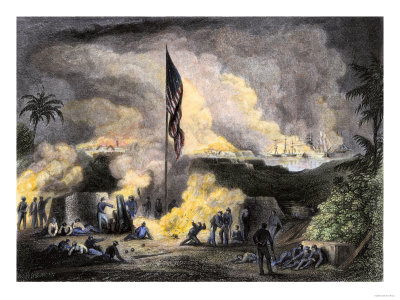
Timeline[]
June 15, 1846 - President Polk refuses the Oregon Treaty with Great Britain. American soldiers seize Forts Okanogan and Vancouver from British control on the Columbia River and begin sending large numbers of soldiers and supplies west along the Oregon Trail.
June 20, 1846 - The British Empire declares War on the United States.
June 27, 1846 - The British Empire signs the Treaty of London with Mexico. Mexico declares War and invades Texas.
July 3, 1846 - The United States signs the Treaty of Moscow with the Russian Empire. Russia's Baltic Fleet moves to engage the Royal Navy in the North Sea.
July 12, - The British and Russian Navies fight the Battle of the Skagerrak, ending in an upset Russian Victory.
July 18, 1846 - Mexican forces begin to lay siege to Austin, Texas for the second time in 20 years.
August 1, 1846 - American reinforcements break the Siege of Austin.
August 3, 1846 - The American Navy is defeated by the British Navy in the Battle of the Saint Lawrence. The British Empire begins to Blockade the American East Coast.
August 14, 1846 - Spain enters the War on the American side. The United States subsequently repeals the Monroe Doctrine; Spain has colonial ambitions in Mexico.
August 22, 1846 - The American, Russian, and British Navies fight the Battle of the Strait of Juan de Fuca. The Americans and Russians defeat the British; a supply line from coastal Siberia and Russian Alaska is secured for the Forts in the Northwest.
October 2, 1846 - The Spanish Armada lands in Puerto Vallarta, Mexico. American forces coincidentally push the Mexican invasion back across the Rio Grande the same day.
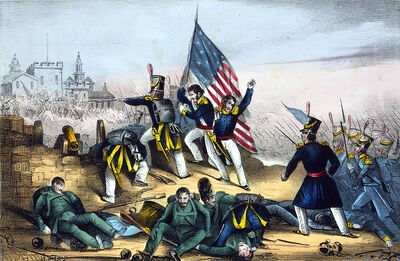
Americans in the Battle of Santa Fe
October 4, 1846 - Following news of the Americans entering Mexico, the separatist movement in the Yucatan begins armed resistance to the Mexican Government. Mexico now faces both invasions from the United States, Spain, and an armed Revolution in the South.
October 25, 1846 - American forces begin to lay siege to Santa Fe.
October 31, 1846 - American and Spanish forces rendezvous and enter Mexico City to little opposition.

A Painting of American Marines entering Mexico City
November 10, 1846 - France enters the War, hoping to capture long-lost territory in Canada from Britain.
November 22, 1846 - American, Spanish, Russian, and French forces break the British Blockade on the United States in the Battle of the Chesapeake Bay.
December 2, 1846 - Americans take Astoria, Oregon.
December 4, 1846 - British forces invade the Eastern United States over the Canadian border. By midnight Britain controls Detroit.
December 31, 1846 - President Polk declares that Alta California and Nuevo Mejico are United States Territories.
January 7, 1847 - Santa Fe falls to American troops.
January 23, 1847 - Under intense pressure from external forces, the Mexican Government capitulates. General Santa Anna is taken into custody by the Spanish Army. A tentative plan to divvy up Mexico between the United States and Spain is drafted; a US-backed puppet state in the Yucatan is planned.
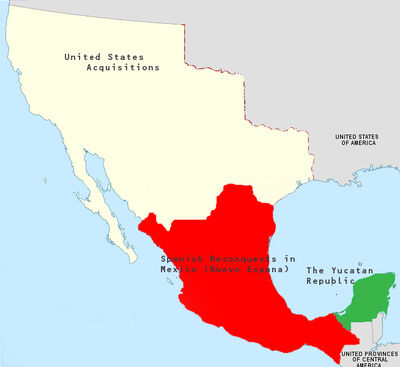
The Divisions of Conquered Mexico
February 23, 1847 - American troops freed from the fighting in Mexico move north, along with the Spaniards, to repulse the British in the Northern United States. The First Convention of New Orleans is held with ambassadors from France, the United States, Spain, and Russia on the aftermath of the war.
March 26, 1847 - American, Russian, French, and Spanish forces retake Rochester, New York from the British.
April 3, 1847 - The British forces in Canada group for a final stand in Montreal. Enemy forces surround the city; several Brigades bombard Montreal from the St. Lawrence River.
April 22, 1847 - British power in North America is ended after the Battle of Montreal. Canada is divided up.
July 4, 1847 - The Second Convention of New Orleans is held. The Victorious Powers agree on the territorial Divisions of Canada. Russia and the United States claim most of Western Canada, France claims eastern Ontario, Quebec (excluding a Spanish corridor running from Newfoundland to the Hudson) and Ellesmere Island, and Spain takes Newfoundland and portions of Quebec. All four nations claim slices of land along the Hudson Bay.
October 4, 1847 - The Second Congress of Vienna is held after Britain complained that the balance of Power in Europe had shifted, undermining the First Congress' purpose. The United States attends the Congress; little is changed.

World Map following the conclusion of the Oregon Wars
January 24, 1848 - Gold is discovered in Alta California territory. This sparks the California Gold Rush.
February 23, 1848 - France plunges into Civil War.
December 2, 1848 - France establishes the Second French Republic.
June 15, 1849 - The United States makes the Oregon Compromise. All territory in the recently acquired western regions North of the Columbia, Snake, and Missouri Rivers was to be Free; territory south would be Slave. Abolitionists call foul; much of the territory declared free was largely uninhabited, while the slave territory contained most of the population centers in the West.
August 6, 1849 - Henry Clay founds the city of "West Monrovia" at the south end of the Puget Sound in Oregon Territory as a haven for freed slaves. Wagon Trains traveling west on the Oregon Trail begin continuing to the new Port City.
March 1, 1850 - The population of West Monrovia skyrockets as gold is discovered to the North of the city near Mount Baker. The Lone Jack Mine quickly becomes established. Soon after, prospectors discover gold up the coast on Queen Charlotte Island. (The Prospector actually sparked the rush after purchasing a 27 ounce nugget of Gold off a local Haida Indian for 1,500 blankets.) This marks the beginning of the Great Gold Rushes, where millions of prospectors from around the globe flooded the West coast of the United States and Russian America.
April 4, 1850 - Alta California is admitted as a Slave State to the Union.
June 13, 1850 - The first Non-African Slaves are sold by the Spanish in San Diego; Chinese sailors captured in the South Pacific. This sparks the brief Shanghai Crisis, in which the United States makes it illegal for a Non-Black to be a slave. The Captured Sailors are returned to China; however, the forced indentured servitude of Asians, mostly Chinese, becomes more common in the Gold Mines and on railroad lines.
August 2, 1850 - Oregon is admitted to the Union as a Slave State.
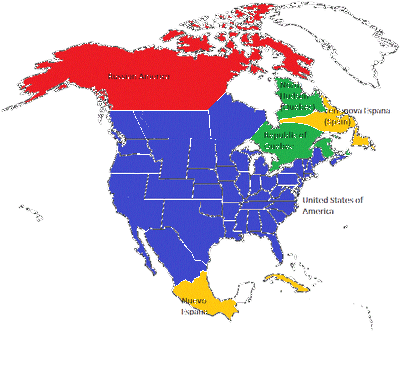
North America in 1850
October 16, 1850 - French Quebec revolts against French colonial authorities.
January 7, 1851 - Monroe is admitted as a Free State to the Union.
February 14, 1851 - Quebec is recognized by the French Republic as a sovereign nation. The Quebecois declare their nation République libre du Québec, or the Free Republic of Quebec.
November 11, 1851 - The State of Deseret enters the Union as a Slave State.
December 1, 1851 - Nuevo Mexico is admitted to the Union as a Slave State. Silver is discovered in Deseret; prospectors flood to the new Comstock Mine.
February 14, 1852 - Quebec holds it's first Independence Day celebration. Delegates from Europe and the United States attend.
April 3, 1852 - Russia founds the city of Alexsandrograd on the Hudson Bay.
September 22, 1852 - Brunswick is admitted to the Union as a Free State.
October, 1853 - The Crimean War is sparked. The French, Ottomans, British, Sardinians, and the Duchy of Nassau declare war on Russia.

The United States in 1855
January 7, 1854 - French and British ships accidentally sink an American Frigate in the Hudson Bay near Alexsandrograd; President Winfield Scott sets the US Hudson Bay Fleet on high alert.
January 30, 1854 - Greeks in Epirus revolts against the Ottomans.
March 18, 1854 - Diamonds are found in remote Russian America. The "Diamond Trail" is forged, running from Novoarkhangelsk on the Pacific Coast, through the Diamond Fields in the interior, to Alexandrograd on the Hudson.
August 30, 1854 - Petropavlovsk is shelled by French and British forces. The American trade vessel Mary-Catherine is sunk at port in Petropavlovsk; President Scott issues warnings to the British and French about sinking any more American Vessels.
September 19, 1854 - Another American merchant vessel is sunk off the coast of Novoarkhangelsk. The United States formally boycotts Britain, France, and the Ottomans and begins selling supplies exclusively to the Russians.

British Soldiers in the Battle of Alma
September 20, 1854 - The Russians lose the Battle of Alma.
September 25, 1854 - The Siege of Sevastopol is initiated.
October 25, 1854 - The Imperial Russian Army triumphs in the Battle of Balaclava. This is the first battle in which the American Corps of Volunteers, an American mercenary regiment (funded by, but separate from, the United States Government), fights.
November 5, 1854 - The Russian Army triumphs once more in Inkermann, Russia.
February 17, 1855 - The Battle of the Chernaya River begins. The Battle of Eupatoria also begins.
February 21, 1855 - The Russians triumph in the 3-day Battle of the Chernaya River. The Siege of Sevastopol is broken.
April 2, 1855 - The Allied Powers offer Truce to Czar Nicholas; the Czar accepts. This established Russia as a World Power.
October 19, 1855 - Prussia invades the Yucatan Republic, attempting to establish its own colony in the New World. The United States and Russia do not intervene; rumors fly about a secret treaty or bribe money paid to President Scott. In truth, Russia and the United States are hoping to gain an ally in eastern Europe by allowing the Prussians free-reign in Central America.
November 1, 1855 - Russia, the United States, Prussia, and Quebec sign the West Monrovia Accords, outlining Trade and Immigration Laws in North America. Noticeably absent is Spain.
January 9, 1856 - The United States joins the Prussians in the Prusso-Yucatan War.
February 18, 1856 - The Yucatan Republic capitulates and surrenders to the Prusso-American forces. Prussia annexes the Yucatan; the United States is given Cozumel Island. A Trading Post and Military Base is quickly established; as civilians move to support the Soldiers, the Island is placed under the Jurisdiction of the State of Texas.
January 9, 1857 - The Mexicans in New Spain revolt against the Spanish authorities. The United States and Prussia both support the rebels under Ignacio Comonfort.
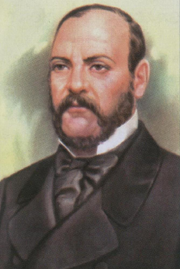
Mexican Rebel Leader Ignacio Comonfort
October 1, 1858 - The Kingdom of Spain declares War officially on the United States and Prussia. Almost immediately, Russia and Quebec declare War on Spain. The Second Mexican Revolution morphs into the Second Atlantic War.
November 4, 1858 - American, Russian and Quebecois forces invade Spanish Canada. The American Navy lands in St. Johns, Newfoundland, while the Russians and Quebecois march overland.
November 30, 1858 - American and Prussian forces invade New Spain from Nuevo Mejico and the Yucatan Colony, respectively.
December 4, 1858 - France declares its neutrality. Prussia and Russia are allowed to march their armies through France to Spain for 20,000 Francs.
January 18, 1859 - The British Empire declares Neutrality.
July 3, 1859 - Abolitionist John Brown launches a raid on the Federal Armory in Harper's Ferry, Virginia. The raid is unsuccessful; John Brown is shot and killed as he fled with several Abolitionists. Tensions between Pro-Slave and Abolitionists in America reaches an apex.

John Brown in 1859
July 30, 1859 - Spanish forces in Mexico surrender to Colonel Robert E. Lee in Chapultepec Castle, Mexico City.
October 6, 1859 - Russian and Prussian forces defeat the Spanish Army in Valencia.
October 9, 1859 - In the midst of the successful War, Czar Nicholas I announces his plans to abolish serfdom in Russia.
November 22, 1859 - Spanish forces in Canada surrender to Russian General Prince Alexander Menshikov in Charlotte, on the Atlantic Coast.
December 4, 1859 - The Allied forces meet in Washington, DC to discuss the future of the former Spanish Colonies.
December 22, 1859 - Russia and Prussia accept Spain's terms of surrender. Russia annexes the Belearic Islands; Prussia takes Valencia as an oversea's territory, similar to Gibraltar.
January 18, 1860 - The Allied Powers come to an agreement regarding captured Spanish Territories: All of mainland Spanish Canada is ceded to the Quebecois, while Newfoundland is ceded to the Russians. Prussia gains the Mexican States of Tabasco and Chiapas; the rest of New Spain is granted independence as the Mexican Republic. Under the terms of Spain's surrender, the United States takes possession of the Philippine Islands. The United States cedes 250,000 sq mi of southern Nuevo Mejico to the Mexican Republic as restitution for 1851 conquests.

North America following the Prusso-Yucatan War
November 6, 1860 - Republican Abraham Lincoln loses the US Presidential Election to Democratic Candidate John C. Breckinridge. Breckinridge promises to preserve the Institution of Slavery , angering the Free-State Minority but pleasing the Slave-State majority.

President John Breckinridge
December 3, 1860 - Oregon passes Anti-Slave legislation, making it the first Slave State to outlaw Slavery.
December 5, 1860 - Czar Nicholas passes away, leaving the throne to his son, Alexander II.
December 16, 1860 - Czar Alexander passes the Emancipation Act of 1860, effectively finishing his father's work to free the Russian serfs.
January 6, 1861 - Deseret passes Anti-Slave Legislation. President Breckinridge, while staunchly against the Abolitionist Movement, makes a speech declaring that each state had the right to decide whether or not slavery is legal.
March 4, 1861 - The Non-Slave States send representatives to West Monrovia in the Free Conference of 1861. The option of secession from the United States is proposed; the proposition is rejected, however. President Breckinridge regards the conference wearily.
October 5, 1861 - France declares war on Prussia. Although no other nations send troops to either side, there is great interest in the war; Spain, the German Confederation, and Britain all declare their hopes in a French victory, while the United States, Russia, and the Ottomans all pledge their support for the Prussians.

French Lancers guarding captured Prussian soldiers
December 15, 1861 - The American Warship USS Constitution, one of the oldest in the American Navy and loved by the American public is fired upon by a French frigate in the Bay of Biscay. The ship survives the attack and makes it to port in Plymouth, England; Franco-American relations, however, are severely damaged. President Breckinridge initially considers war on France; however, the possibility of drawing Britain into the war is too great.
January 6, 1862 - Oregon and Monroe both agree to cede the eastern portions of both states to form the Territory of Washington. A similar movement in Montana begins to give the southern portion of the state autonomy as the Territory of Wyoming.
May 18, 1862 - Britain, the United States, Russia, Sweden-Norway, and Austria sign the London Peace Accords, pledging never to wage war against one another again. The US public, in particular, is highly supportive of re-establishing relations with Britain.
December 5, 1862 - Slaves in the Gold Mines of California revolt in Coloma. The revolting slaves escape US Marshals dispatched to put the rebellion down into the forest.
January 17, 1863 - The Coloma Slave Revolt, led by slave Benjamin Johnstone, raids the outskirts of Sacramento, California, with aid from the local Nisenan Indians. The raid is successful; the raiding party disappears before the defenders could marshal retaliation.
January 30, 1863 - The Coloma Slave Revolt is ended as a local posse, with aid from both the US Marshals and a contingent of US Army Soldiers, crushes the slaves' encampment on the American River. Benjamin Johnstone is hung under charges of treason, grand theft and murder.
